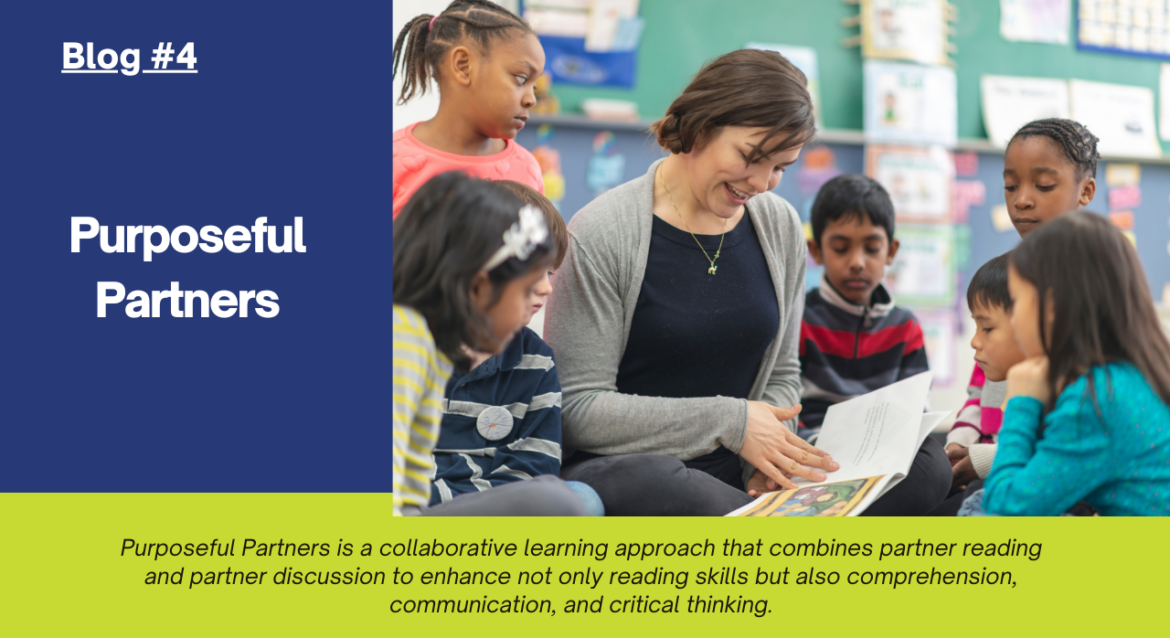
Purposeful Partners is a collaborative learning approach that combines partner reading and partner discussion to enhance not only reading skills but also comprehension, communication, and critical thinking. This strategy draws from research by Leung (2015), Topping & Lindsay (1992), and Topping et al. (2012), which underscores the positive impact of peer collaboration on academic performance. Purposeful Partners involves pairing students with varying abilities to engage in shared reading and meaningful discussions, fostering holistic development. The Reading Focus Folder in STRIVE’s Data System- A how to on planning, teaching, and assessing reading groups, is a great resource for setting up purposeful partners. www.strivetlc.com/strives-data-system/.
Why use purposeful partners?
The Purposeful Partners approach serves multiple educational goals. It harnesses the power of peer interaction to improve reading fluency, comprehension, communication, and critical thinking skills. By integrating reading and discussion, students not only enhance their understanding of content but also develop the ability to articulate their thoughts, listen actively, and collaborate effectively.
How to Implement Purposeful Partners:
- Pair Partners: Divide the class into two lists based on expertise and student assessment scores. Match proficient and less proficient students in pairs. Consider individual needs and adjust pairings as necessary. If you use STRIVE’s Data System- A how to on planning, teaching, and assessing reading groups, then the Reading Focus Folder is a great resource to use. Partner students in Group D with students in Group B and students in Group C with students in Group A. If you have a lot of students on the left side of your Reading Focus Folder, then make the two lists using their overall reading scores.
- Set Expectations:
- Explain the Purposeful Partners approach and its objectives to students.
- Define the roles of “Partner Reader” and “Partner Discussant” and their responsibilities in the process.
- Clarify expectations for active listening, articulation, and respectful feedback.
- Reading and Discussion Ideas:
- Begin with partner reading: one student reads aloud while the other follows silently.
- After a section, partners switch roles, ensuring both experience reading and listening.
- Move into partner discussion: pose open-ended questions or prompts related to the reading.
- Partners engage in a dialogue, sharing insights, opinions, and evidence from the text.
- Guide Conversations:
- Provide prompts that encourage critical thinking, inference, and application.
- Model effective discussion techniques, such as paraphrasing, asking probing questions, and offering evidence.
- Encourage both partners to contribute equally and respectfully challenge each other’s ideas.
- Expand Complexity:
- Gradually increase the complexity of reading materials and discussion topics.
- Incorporate activities that require partners to synthesize information or connect ideas across texts.
- Support and Reflect:
- Monitor partner interactions, providing guidance and support as needed.
- Offer feedback to partners on their discussion skills and collaborative efforts.
- Foster reflection by asking partners to consider what they’ve learned from each other.
Success For Teachers
- Teachers observe engaged pairs during reading and discussions.
- Students demonstrate active listening, articulate communication, and respectful exchange of ideas.
- Reading comprehension and critical thinking skills show improvement over time.
- Collaborative learning reduces the need for constant teacher intervention.
Success For Students
- Students enhance reading fluency and comprehension through shared reading.
- Communication skills improve as they engage in meaningful discussions.
- Critical thinking abilities are honed through thoughtful analysis and evidence-based discussions.
- Collaborative partnerships foster a positive classroom environment.
Scenarios to Plan and Monitor
- Students may engage in superficial discussions without delving into the text’s deeper meaning.
- Uneven participation can occur, with one partner dominating the discussion.
- Misinterpretation of discussion expectations might lead to unproductive exchanges.
- Lack of clear instructions can result in confusion about roles and activities.
By integrating reading and discussion through Purposeful Partners, educators can create a dynamic learning environment where students collaborate, communicate, and critically engage with content. The comprehensive approach enhances students’ overall literacy skills while fostering a deeper understanding of the material and meaningful peer interactions.
Keep scrolling for Purposeful Partner Resources you can use right now!
For more information on STRIVE’s Data System- A how to on planning, teaching, and assessing reading groups, visit www.strivetlc.com/strives-data-system/.
Note: While Partner A may initially take on the specific responsibilities listed in the examples below, such as reading or responding to questions, these roles are flexible and should be flipped, thus ensuring both partners have the opportunity to develop a range of skills, actively engage in reading, writing, and discussion and contribute meaningful to improve reading, writing, and discussion skills and increase knowledge of content.
Purposeful Partner Examples
Reading Challenges
Partner A
Reads a paragraph that includes the word “perplexing.” Pauses and looks at Partner B.
Partner B
Notices Partner A’s pause and says, “I think ‘perplexing’ means confusing or puzzling. You’re doing great with the reading!”
Possible Scaffolds:
- Scaffolding for Partner A: The teacher could pre-identify challenging words and provide definitions or synonyms to Partner A. This helps them feel more confident when reading challenging passages.
- Scaffolding for Partner B: The teacher might encourage Partner B to look out for difficult words and actively participate in defining them, fostering a collaborative approach.
Question Response: Teacher: Asks, “Why did the explorer decide to go on this adventure?”
Partner A
Partner A (Reader): Responds, “The explorer wanted to find hidden treasures and prove their bravery.”
Partner B
Adds, “Also, the explorer was inspired by stories of past adventurers in their family.”
Possible Scaffolds:
- Scaffolding for Partner A: The teacher could guide Partner A by asking leading questions to help them formulate responses. For example, “What reasons might someone have for embarking on an adventurous journey?”
- Scaffolding for Partner B: The teacher may help Partner B by asking probing questions that prompt them to think more deeply about the text. For instance, “Can you think of other stories where family history inspired someone to do something?”
Two-Part Question: Teacher: Presents a two-part question, “Describe the challenges the explorer faced during the adventure. How did they overcome these challenges?”
Partner A
Partner A (Reader): Addresses the first part, “The explorer encountered rough terrain and wild animals.”
Partner B
Takes on the second part, “To overcome these challenges, the explorer used their knowledge of survival skills and built a shelter.”
Possible Scaffolds:
- Scaffolding for Partner A: The teacher might provide a graphic organizer with two columns, one for each part of the question. This helps Partner A organize their thoughts and answer each part accurately.
- Scaffolding for Partner B: The teacher could offer sentence starters for Partner B’s response to the second part, such as “One way the explorer overcame challenges was…”
Summarizing Discussion
Partner A
(Reader): Concludes reading a section of the story where the explorer finds the hidden treasure.
Partner B
Summarizes the reading, “So, the explorer’s determination and courage led them to uncover the treasure they were searching for.”
Possible Scaffolds:
- Scaffolding for Partner A: The teacher could give Partner A a sentence stem to begin their summary, like “In this section, the explorer…”
- Scaffolding for Partner B: The teacher may provide a sentence frame for Partner B’s summary, such as “From what Partner A read, it seems like the explorer’s determination led them to…”
Higher Level Questioning: The teacher poses a higher-level question that requires analysis of the explorer’s internal conflict and its impact on decision-making.
Partner A
- Reads the section of the text related to the explorer’s internal conflict and ponders the question. They respond, “The explorer faced an internal conflict between their desire for adventure and their responsibility to their family.”
- After Partner B provides examples, Partner A also connects the internal conflict to broader themes in the story. For instance, they might discuss how the explorer’s struggle symbolizes the tension between personal aspirations and societal expectations.
- Both partners engage in a reflective conversation, bouncing ideas off each other and building a comprehensive analysis of the character’s internal conflict.
Partner B
- Partner B engages in a more detailed discussion by expanding on Partner A’s response. They say, “Yes, I agree. This conflict made the explorer’s decisions more challenging. For example, they had to balance their longing for exploration with the need to ensure their family’s well-being.”
- Partner B delves further into the text to provide specific examples/evidence of how the internal conflict influenced the explorer’s actions. They could reference instances where the explorer hesitated before embarking on risky journeys due to the conflicting priorities.
- Both partners engage in a reflective conversation, bouncing ideas off each other and building a comprehensive analysis of the character’s internal conflict.
Possible Scaffolds:
- Scaffolding for Partner A: The teacher might provide bullet points or guiding questions related to the internal conflict for Partner A to refer to during their response.
- Scaffolding for Partner B: The teacher could suggest specific pages or paragraphs from the text that Partner B can use to support their discussion points.
Teacher’s Engagement Monitoring and Support: Teacher monitors purposeful partners, provide supports as needed and assesses engagement by:
- Noticing if both partners are actively participating during reading and discussions.
- Asking individual partners about the content they’ve read and discussed.
- Rotating partners periodically to ensure everyone experiences both roles.
- Encouraging partners to provide feedback to each other on their contributions.
- During class discussions, prompting Partner A to share a reading highlight, and Partner B to share an interesting question or insight from their discussion.
Additional Scaffolds Based on Teacher Monitoring and Support:
- The teacher can provide a checklist so students can stay on task and remember the steps. This helps the teacher keep track of interactions and participation.
- The teacher can use a timer to ensure both partners get equal time to read and discuss, especially if one partner tends to dominate the conversation.
- The teacher could offer mini-conferences during the session, briefly checking in with each partner to ensure they’re on track and engaged.
- Peer feedback forms could be provided to help partners assess their own contribution and their partner’s contribution. The teacher can review these forms to gauge the quality of collaboration.
Use this checklist with students to guide your interactions during Purposeful Partners sessions when facing reading challenges. This will help students stay engaged and accountable.
Reading Challenges:
Partner A (Reader)
- Read with expression and clarity.
- Pause when encountering challenging words or phrases.
- Make eye contact with Partner B during pauses.
- Ask for assistance if a word is unclear.
- Take turns smoothly with Partner B.
Partner B
- Listen actively to Partner A’s reading.
- Be prepared to offer help with difficult words.
- Prompt Partner A if they pause or hesitate.
- Use context clues to help define unfamiliar words.
- Be ready to summarize what Partner A read after each paragraph.
- Be an attentive and supportive partner.
Ideas for Teacher Monitoring and Support:
- Observe if both partners are engaged and participating.
- Check if Partner A seeks assistance when facing reading challenges.
- Notice if Partner B provides helpful explanations for difficult words.
- Monitor for effective collaboration between partners.
- Encourage a positive and cooperative learning environment.
- Provide feedback to partners on successes and ideas for improvement.
Use this checklist with students to guide their interactions during Purposeful Partners sessions when responding to questions. This will help students stay engaged and accountable.
Partner A (Reader)
- Listen attentively to the question from the teacher or read and reread the question as needed.
- Take a moment to gather your thoughts before responding.
- Provide a clear and concise response to the question.
- Include relevant details or evidence from the text.
- Collaborate with Partner B to answer fully.
Partner B
- Listen actively to Partner A’s response.
- Add to Partner A’s response if there are additional points.
- Use evidence from the text to support your contributions.
- Be ready to elaborate on or clarify responses.
- Engage in a meaningful discussion with your partner.
Ideas for Teacher Monitoring and Support:
- Observe if both partners are engaged and actively responding.
- Check if Partner A’s response addresses the question effectively.
- Notice if Partner B contributes to the discussion with meaningful insights.
- Monitor for equal participation between partners.
- Encourage respectful and thoughtful exchange of ideas.
- Provide feedback to partners on successes and ideas for improvement.
Print and Use: Checklists
We must take care of the teachers, leaders, and coaches that take care of our children.
-Debbie
Our aim is simple: to provide as many helpful resources as possible to teachers, leaders, and coaches. Every comment you make and every share helps us achieve this goal.
Leave a Comment: Your thoughts and experiences are valuable to us and other readers. Join the conversation and help us all learn more!
Share with Others: Know other teachers who could benefit from our resources? Spread the word and help us reach more educators


